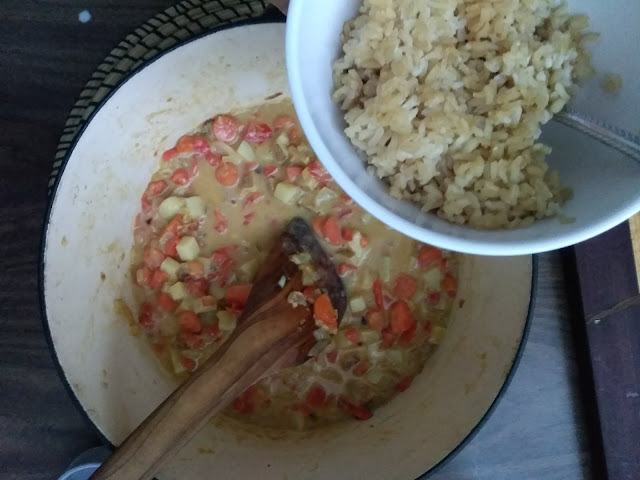This is pot pie made out of half-used old fridge veggies and a jar of chicken fat. Sounds great, right?

Ready for some bad photos?? (My camera of ten years finally sort of kicked the bucket).
In this thing are potatoes, carrots, red pepper, onion, and some worth-their-weight-in-gold roasted chicken thigh drippings from an earlier meal.
Gone in less than 24 hours.
Here's how to make it:
Start by dicing an onion, two medium carrots, one russet potato, and half a red pepper
Heat up some olive oil until shimmering, and add onions and carrots. Saute for five to seven minutes in the pot, before the pepper and potato join the party.
After the peppers and potatoes soften, add the chicken drippings. Much like in this recipe, I used leftovers from a dish at work: Middle Eastern roasted chicken thighs with cumin, whole garlic cloves, coriander, chili flakes, salt, and half a minced preserved lemon.
You could easily pan-fry (skin-side down) a couple of small chicken thighs tossed in olive oil and those spices, and then add the rendered fat and shredded meat to the pie.
I'd recommend:
1 teaspoon each of coriander and chili flakes
2 teaspoons cumin
1/2 teaspoon salt
4 whole garlic cloves
2 tablespoons minced preserved lemon
So, at this point, reduce the heat to medium-low and add a couple tablespoons of the fat (add any shredded meat later, if you're including it). Stir until the fat melts, and add an equal volume of flour.
My light really started fading around this time, btw
My light really started fading around this time, btw
Stir in the flour until it thoroughly coats all the vegetables. Add about a cup of milk - you want it like a thick, creamy soup.
Once the milk is stirred in, turn off the heat. At this point, I added 1.5 cups of some leftover cooked brown rice I had in the fridge. Any sort of cooked grain will work. Stir until combined.
After the rice is incorporated, add any shredded meat you'd like (I'm just working with chicken fat, so I didn't add any).
Now for the dough! I'm using a standard, unsweetened and butter-based pie dough:
1 part salted butter
2 parts flour
A few tablespoons of water
Place frozen cubes of butter into a pile of flour
Pinch and tear apart the cubes with your hands (or cut with a pastry cutter or two knives) until the butter pieces are the size of large peas (not chickpeas. Green peas.)
Add a tablespoon of very cold water at a time to the mix of butter and flour. Toss the mix with your hands, instead of kneading, until it begins to clump together in large, shaggy pieces.
Add a tablespoon of very cold water at a time to the mix of butter and flour. Toss the mix with your hands, instead of kneading, until it begins to clump together in large, shaggy pieces.
Press the clumps together, fold the resulting mass in half, and press down with the heel of your hand. Repeat a couple of times, until the mass stays together and very little loose flour remains. It should look a bit like this:
.....................................................................................
If this is all too much, I have a cheat for you. My family has used this recipe for years. It's oil-based, and makes a crisp, flaky crust that is great for using with fillings that don't collapse in height. If you're making fruit pies, use a butter-based crust, because the crust will stay WITH the filling as it reduces in the oven.
This recipe will create one pie crust. Double this if you want a top AND bottom crust.
1/2 cup vegetable oil
1/4 cup milk
2 cups flour
1/2 tsp salt
Mix the dry and wet ingredients separately. Pour the wet into the dry all at once and stir quickly, stopping when the dough is just combined and still crumbly. Knead with your hands until there are no crumbs left, and then roll out quickly between two nonstick surfaces, like parchment, plastic wrap, or silpats. Use as soon as possible, since waiting will cause the dough to dry out and separate.
BAM, pie crust. Enjoy!
................................................................................................
Anyway, back to the butter crust.
Roll out your pressed-together mass (flipping and flouring both sides if needed) until its diameter is slightly larger than that of the pot.
BAM, pie crust. Enjoy!
................................................................................................
Anyway, back to the butter crust.
Roll out your pressed-together mass (flipping and flouring both sides if needed) until its diameter is slightly larger than that of the pot.
I folded this circle into quarters, placed the dough right on top of the filling, and unfolded it, tucking the ragged edges under where they meet the pot sides.
Brush the top of the dough with milk and poke some holes in it with a fork or knife. Bake at 425 degrees for half an hour, or until the filling is bubbling and the crust is cracked and brown.
































































